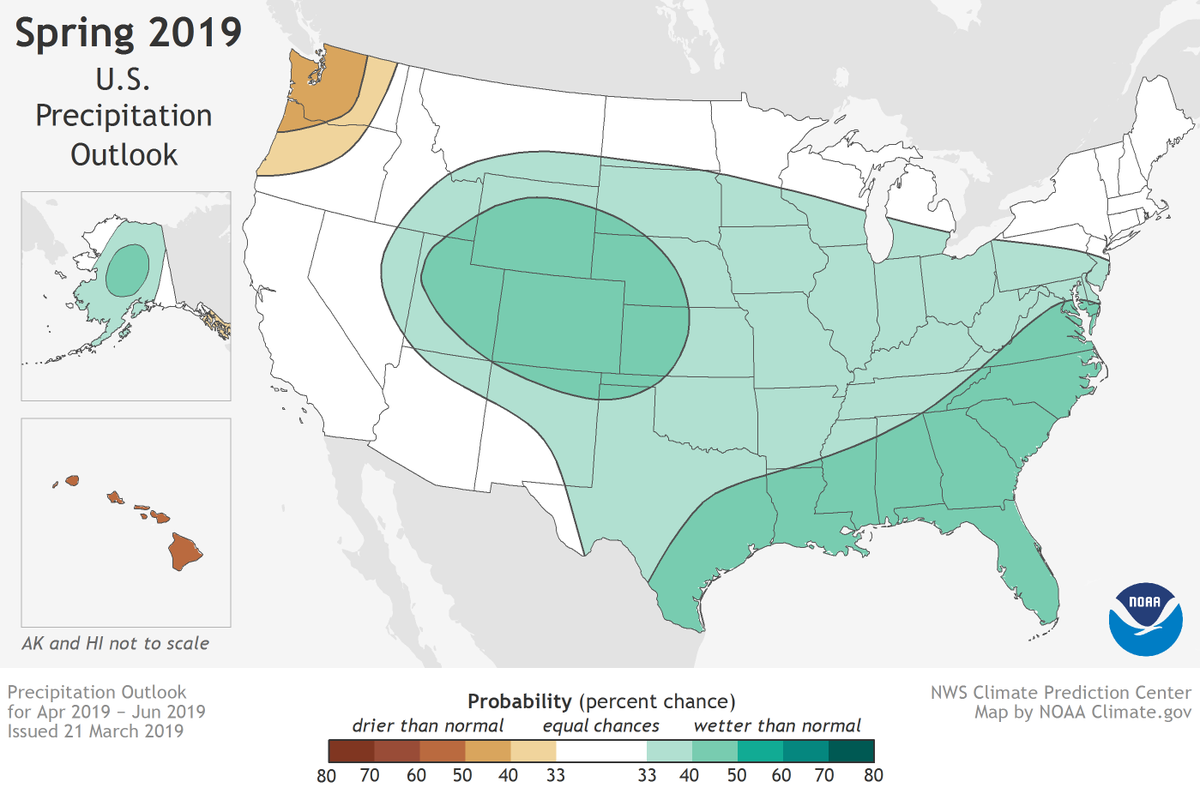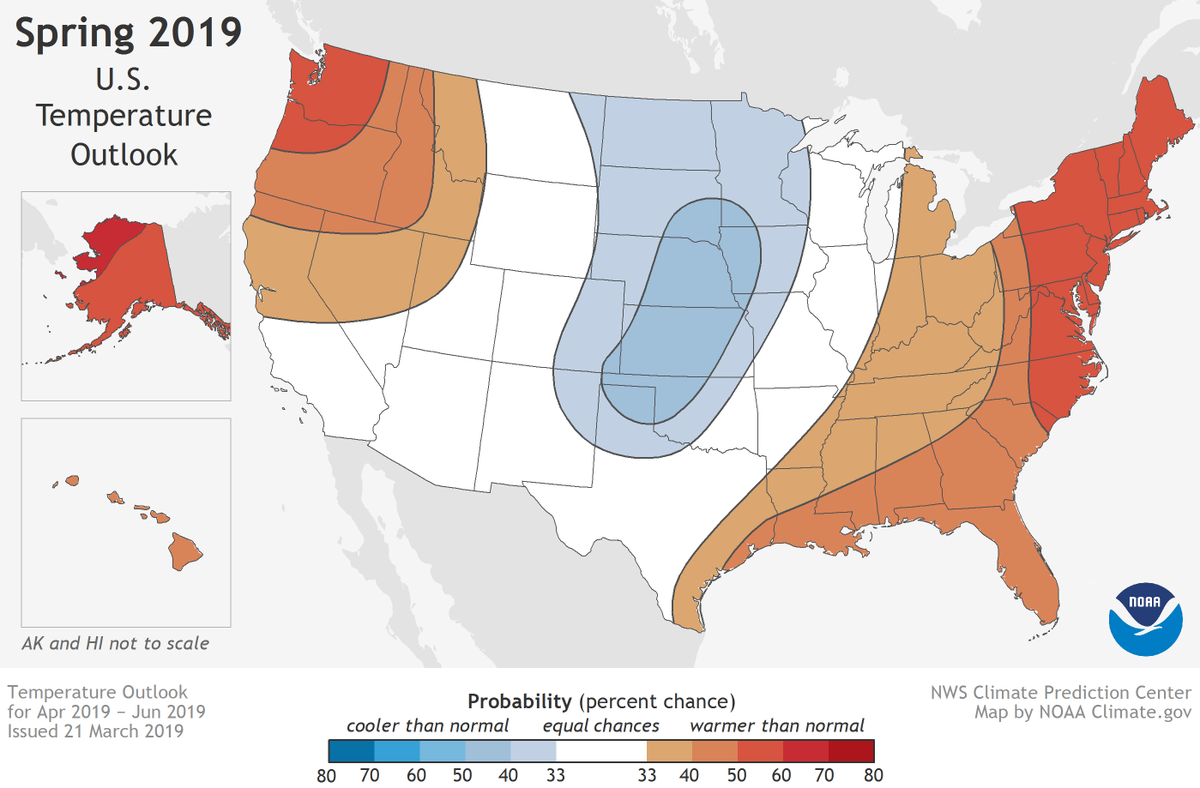Friday March 22nd… Dear Diary. The main purpose of this ongoing post will be to track United States extreme or record temperatures related to climate change. Any reports I see of ETs will be listed below the main topic of the day. I’ll refer to extreme or record temperatures as ETs (not extraterrestrials).😉
A Wet Spring Outlook For The U.S. Midwest
Apparently it has been determined by those looking at long range meteorological models that the storm track, which has stubbornly been moving through the Midwest over the winter producing copious amounts of precipitation ramped up by climate change, won’t change enough over the spring to bring much relief to flooded areas. In fact, the outlook hints that conditions may get worse before they get better for residents of Nebraska and Iowa, two of the hardest hit states. Being a forecaster and looking at models going through early April I can see the logic here, but I pray that somehow such a dire forecast does not come to pass.
For details today I will turn to the ever reliable New York Times:
https://www.nytimes.com/2019/03/21/climate/climate-change-flooding.html
Reposting this article:
25 States Are at Risk of Serious Flooding This Spring, U.S. Forecast Says
Flooding in Hamburg, Iowa, on Monday. Credit: Tim Gruber for The New York Times


- March 21, 2019
Want climate news in your inbox? Sign up here for Climate Fwd:, our email newsletter.
Vast areas of the United States are at risk of flooding this spring, even as Nebraska and other Midwestern states are already reeling from record-breaking late-winter floods, federal scientists said on Thursday.
Nearly two-thirds of the lower 48 states will have an elevated risk of some flooding from now until May, and 25 states could experience “major or moderate flooding,” according to the National Oceanic and Atmospheric Administration.
“The flooding this year could be worse than anything we’ve seen in recent years, even worse than the historic floods of 1993 and 2011,” said Mary C. Erickson, deputy director of the National Weather Service, in a conference call with reporters. The major flooding this month in Nebraska, Minnesota, Iowa and elsewhere is “a preview of what we expect throughout the rest of the spring,” she said.
Some 13 million people could be exposed to major flooding, making this a “potentially unprecedented” flood season, said Edward Clark, director of NOAA’s National Water Center.
And much of the United States east of the Mississippi River, as well as parts of California and Nevada — in total, areas home to more than 200 million people — could see at least some flooding in the spring, the scientists said.
The projections were part of NOAA’s annual “Spring Outlook,” though the language of the 2019 report carried greater urgency than usual. That is not surprising, since the basins of the Upper Mississippi and the Red River of the North have already been hit with rain and snow this spring of up to twice normal levels.
“We’ve set over 30 records in Nebraska, Iowa and South Dakota” in the last week alone, said Kevin Low, a scientist with the National Weather Service’s Missouri River Basin Forecast Center. That flooding has devastated farmers and ranchers across the region, put communities like Hamburg, Iowa, underwater, and wiped out roads and bridges in others.
Gov. Pete Ricketts of Nebraska put a preliminary estimate of $1.4 billion in damages in his request for a federal disaster declaration, including $439 million in damages to public infrastructure and $85 million to homes and businesses.
Above-average rainfall that scientists expect for the spring, along with melting snow, would add to the flooding and extend it through the central and southern United States. NOAA identified the greatest risks for moderate to major flooding in the upper, middle and lower Mississippi River basins, the Red River of the North, the Great Lakes, and the eastern Missouri River, lower Ohio River, lower Cumberland River and Tennessee River basins.
The agency’s scientists also predicted that the chemical runoff from the rains would cause above-average hypoxia conditions — “dead zones” of water with low oxygen caused by nutrient pollution that can kill fish and other marine life — in the Gulf of Mexico and Chesapeake Bay.
More rainfall in the Midwest is a predictable consequence of climate change, according to the most recent National Climate Assessment, which was produced last year by 13 federal agencies. A warmer atmosphere can hold more moisture, which comes down as precipitation.
The current flooding in the Missouri River basin and beyond has been caused in part by heavy rains, but has been further complicated by other factors, like frozen ground that kept water from being absorbed.
Andrew Dessler, a professor of atmospheric sciences at Texas A&M University, said that understanding the role of climate change in weather events like the Nebraska floods required applying the tools of a growing field known as attribution science. “Without doing the analysis, you don’t know what role climate change played,” he said. “Certainly, floods happened before climate change.”
However, he added, heavier rainfall events are among the most common conditions associated with climate change. Humans have loaded so much planet-warming carbon dioxide into the atmosphere that “the starting assumption has to be that climate change is affecting everything” to some extent, he said.
“The real question isn’t, ‘Is climate change playing a role?’” Dr. Dessler said. “It’s, ‘How big a role is climate change playing, and what is the role?’”
The National Weather Service describes moderate flooding as involving some inundation of structures and roads near streams, with some evacuations; major flooding involves extensive inundation of structures and roads and significant evacuations.
By comparing this year’s potential flooding to the seasons of 1993 and 2011, Ms. Erickson was citing some of the worst weather disasters the United States has faced since the Great Mississippi Flood of 1927.
The 1993 flood in the Midwest killed 50 people and caused $15 billion in damages; a reporter for The New York Times called it “a watery rampage by nature like no other.”
In the 2011 floods, the Army Corps of Engineers took the extraordinary measure of blowing up 11,000 feet of Mississippi River levee to let water flow into the Birds Point floodway in Missouri, saving the little Illinois town of Cairo but inundating more than 100,000 acres of farmland and homes.
For more news on climate and the environment, follow @NYTClimate on Twitter.
Here are the official NOAA outlook charts:


The very wet ground could produce an increasingly rare “cool pocket” over a portion of the planet, in this case the Midwest. We will see how all of this pans out as spring continues.
………………………………………………………………………………………………..
Here is some more climate and weather news from Friday:
(As usual, this will be a fluid post in which more information gets added during the day as it crosses my radar, crediting all who have put it on-line. Items will be archived on this site for posterity. In most instances click on the pictures of each tweet to see articles.)
(If you like these posts and my work please contribute via the PayPal widget, which has recently been added to this site. Thanks in advance for any support.)
Guy Walton- “The Climate Guy”